Table of Contents
What Is Branding?
Branding is a concept or an idea that defines your POV of how you want your users to see you. An example can help you to have a finer understanding of brand identity.
Can you deny that even after saying Starbucks is “overpriced and overhyped,” – you never miss a chance to upload a picture on social media holding that espresso? – This is the power of branding!
Take another instance! How often have you cursed Lays for filling only 5% of the pack with chips and the remaining part with air? But it is difficult to miss its new flavors – the brand is this compelling.
Branding Vs. Marketing
While branding is the idea of how you want your buyers to see your company, marketing is the process of reaching them and convincing them to interact with you. Users will hardly come and download your mobile app; instead, you need to approach them with ads, collaboration, emails, or other means to bring them to the download page.
Based on your branding ideas, you have to determine the marketing strategies:
- Whom to target?
- How do they make purchase decisions?
- How are you planning to attract them?
- Who are your competitors?
- How are the competitors targeting the buyers?
- How do users see their brand and connect with their brand?
- What can you do to leave your competitors behind?
We would like to take you to some more branding details in the least theoretical way. Check it out:
What Are the Core Elements of Branding?
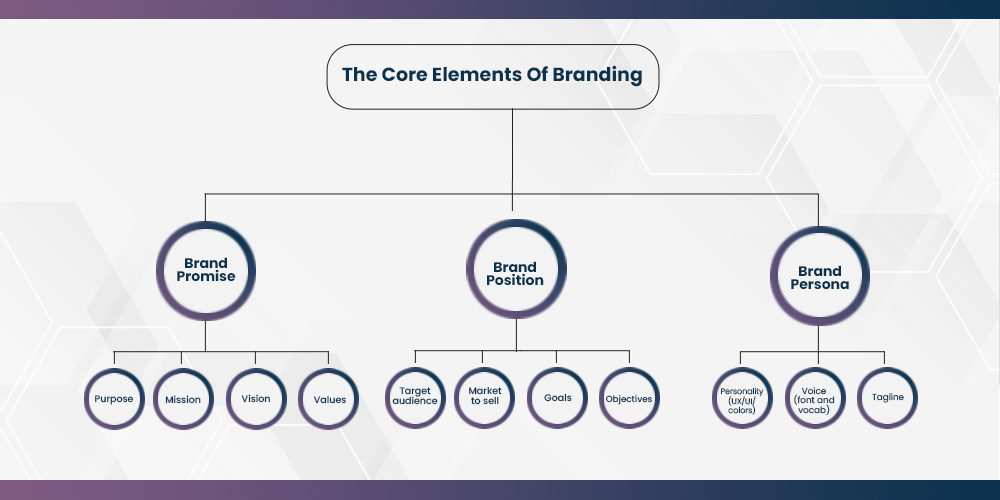
Branding is all about 3 factors: your promise to the users, your positioning to interact with them, and the persona you want to show them. Promise shows your consistency, and positions, on the other hand, will help you to think innovatively by aligning with the thought process of your target audience. Furthermore, a persona is a skeleton of your entire idea in terms of colors, themes (UX/UI), shapes, icons, fonts, vocabulary, logo, headline, slogan, etc.
Booster Elements In Branding
- Brand associations (community)
- Brand story
Enough of theory – time to find the why branding failure occurs.
Commonest Reasons Behind Branding Failures Of Mobile apps
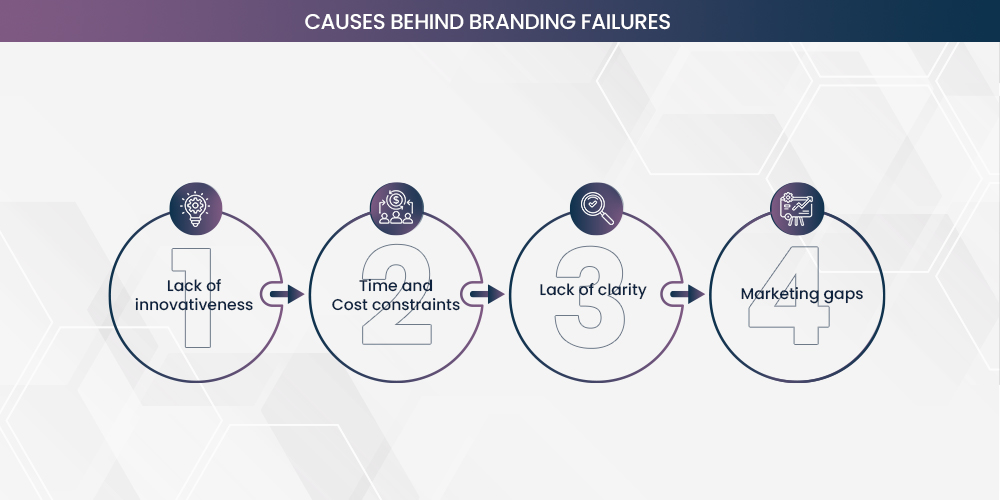 There are 4 basic reasons behind the branding failure of your mobile apps – no matter what the industry is – branding failure causes stays nearly constant.
There are 4 basic reasons behind the branding failure of your mobile apps – no matter what the industry is – branding failure causes stays nearly constant.
1. Lack Of Innovativeness
Creating an eye-catchy factor in the app for the buyers is essential in branding as it is all about connecting with buyers emotionally. So, enough time is needed to research how buyers think and make purchase decisions while shopping from mobile apps and what makes them happy.
Based on this, you can develop a mobile app to connect with them, but branding fails when a team lacks this innovativeness. Inadequate innovativeness will always bring improper outcomes. As a result, strategies will be improper, and there will be a hindrance to connect with your audience.
Tropicana by PepsiCo had around $130 million loss (20%+ of drop in sales) just because of their generic packaging ideas.
2. Time And Cost Constraints
Implementing innovation is not a matter of joke – enough time and investment are needed here. Brainstorming may get stuck if there is any urgency or budget constraints while developing an app. As a result, innovative ideas will not come to the table, and mobile app branding will refrain from resulting in success.
3. Lack Of Clarity
During brainstorming, it is necessary to get multiple points. But for the result-oriented branding strategy of mobile apps, it is essential to pick one direction and go ahead.
This process also stuck if team members lack clarity of the entire branding process. Ultimately, it fails to create a brand identity for your mobile app.
Did you know that Burger King failed badly when launching low-calorie fries to compete with nutritional food companies?
4. Marketing Gaps
Even after good branding, companies may lose because of marketing gaps. Making an appealing brand for a mobile app is not all – it has to reach your audience. Due to improper marketing, your app may fail to establish its brand identity.
In addition to these 4 main reasons, some uncommon reasons behind branding failures are:
- Controversy
- Misinterpretation by buyers
- Sudden change in buyers’ preferences
Also, read: A Complete Guide To Turn Your Shopify Store Into A Mobile App
How To Reverse It?
Too much of a problem, right? But you can reverse it with the right branding and marketing strategies with your mobile app. You can begin with these rapid-fire questions and then move to quick fixes in your mobile app branding strategies to get effective results.
Step 1: Answer These Rapid-Fire Questions To Make An Over The Top Branding Strategy For The Mobile App
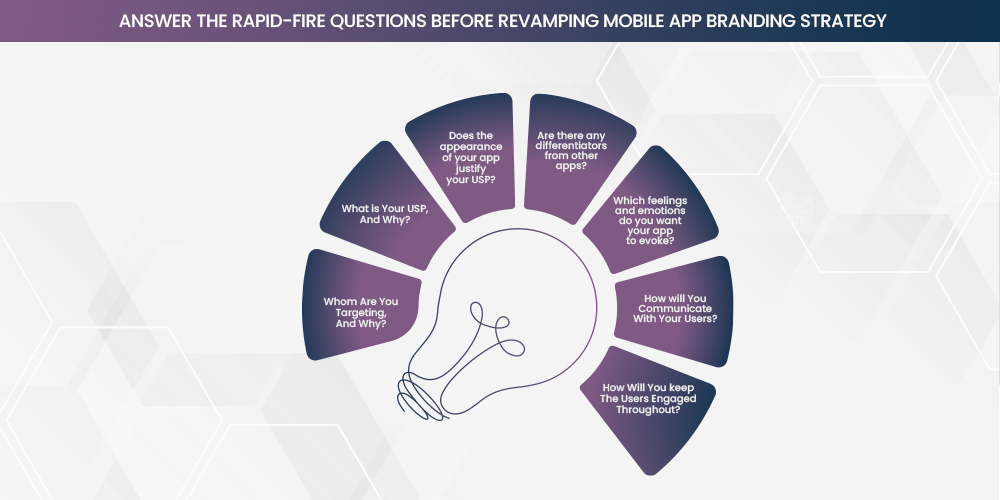
These questions will prepare you for the next part of the branding journey of your mobile app.
Check out: Benefits Of Shopify Mobile Apps – See What Your Business Is Missing Out Without An App
Step 2: Follow These Quick Tips To Revamp Your Branding And Marketing Strategy For Mobile Apps
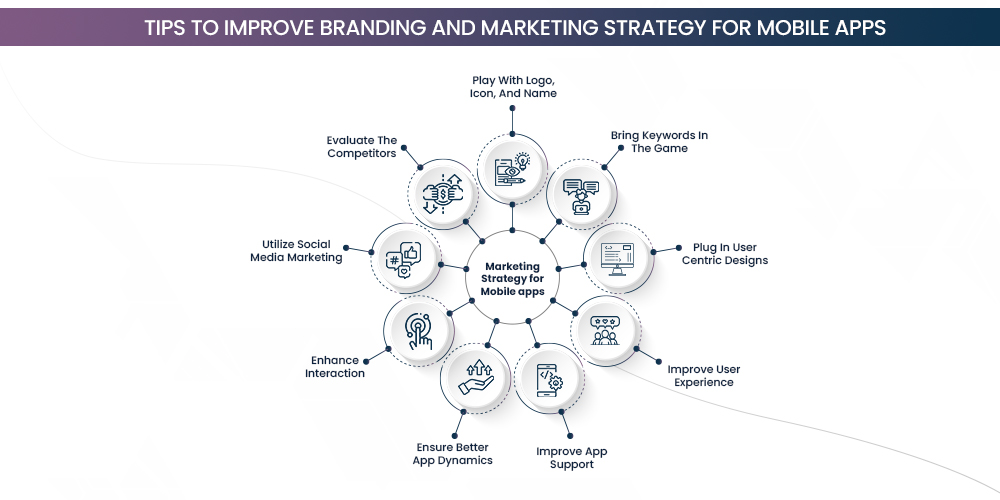 A mobile app is a powerful tool for business – it often fails to get traffic and conversion due to branding and marketing gaps. Find some effective solutions to it:
A mobile app is a powerful tool for business – it often fails to get traffic and conversion due to branding and marketing gaps. Find some effective solutions to it:
1. Play With Logo, Icon, And Name
Pay more attention to the mobile app’s name, logo, and icons to make the branding more impactful. Keep it simple and easy to remember. Also, you have to ensure its uniqueness – it should be free from cliches. Most importantly, no matter how unique your name is, buyers will not turn up if it’s not easy to remember. So, put the majority of your innovativeness here.
Remember: Logo is not just aesthetics – it is the identity – so treat it as a long-term investment.
Did you know that the 2012 Olympics logo (London) made at £400,000 had such drastic changes that a petition was circulated and signed by 40,000+ citizens for hurting their sentiments? It was ultimately redesigned!
2. Bring Keywords In The Game
Once you have created your logo, icon, and name, bring on keywords with high search volumes. Wisely write your headlines, description, meta tags, image tags, and descriptions to enhance the views. It will bring more organic traffic to your mobile app and help to reach your business goals.
You might be interested in 17 Proven Strategies to Increase App Downloads and Installs Revealed
3. Plug-In User-Centric Responsive Designs
For any business, users are the topmost priority. For branding, too, user experience is the prime focus since it aims at connecting with their emotions. Responsive graphics, a catchy theme, responsive UX, etc., can strengthen your mobile app branding by offering the same view on each device. All these will create a long-lasting effect on them, and they will remember you for quite some time.
Unless you value your users, they will not value you. Heineken’s “Sometimes, lighter is better” (for a white wine with low-calorie counts) hit users’ sentiments so hard that they had to apologize and give an explanation for their support.
4. Aim At Improving User Experience
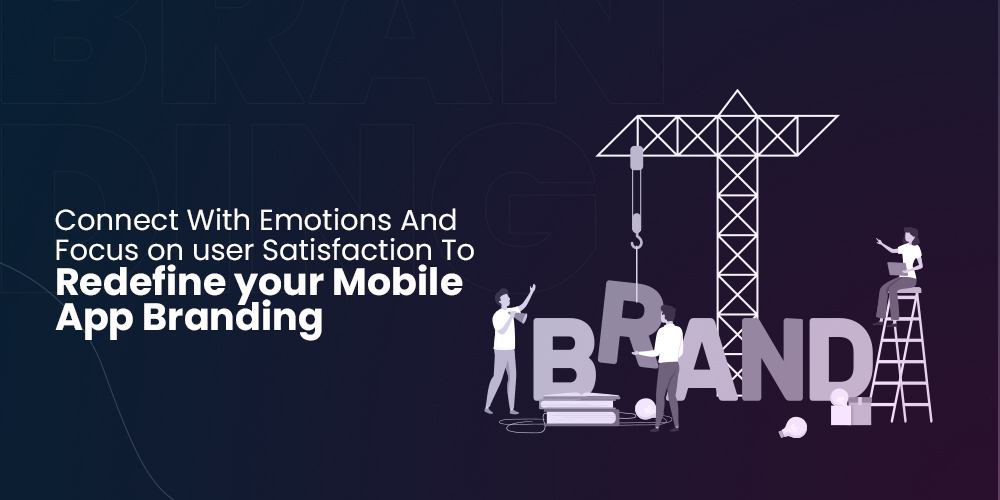 Your mobile app can use personalized onboarding for a better first impression. As a result, users will remember your mobile app for a long time, and your branding goal will be met. Additionally, easy app usage, good features, and gamification can enhance your app’s user experience.
Your mobile app can use personalized onboarding for a better first impression. As a result, users will remember your mobile app for a long time, and your branding goal will be met. Additionally, easy app usage, good features, and gamification can enhance your app’s user experience.
Pro tip: Merchants struggling with brand-building can eliminate stringent return and refund policies to get loyal customers.
Also, check out: Success Story: How MageNative Helped AmorEarth Reach Millions By Using Shopify Mobile App
5. Improve App Support
We are talking about better customer experience – how can we forget about mobile app support? Lack of support can dishearten customers so much that they may never turn up to you.
Therefore, add 24*7 chat, call, and mail support on your mobile app. If your mobile app is missing these features, it will affect your branding. So you have to amend it.
Give a read to 25 KPIs That Measure Performance, Success, And Growth Of Shopify Mobile Apps
6. Ensure Crash-Free And Fast Performance
Mobile app dynamics, too, have a vital role to play in brand-building. Users feel disgusted with the apps that take more than 3 seconds after tapping to bring results. Also, often crash is the reason for limited views and conversions. Therefore you need to use Firebase, API, etc., to make your mobile app responsive and establish brand identity.
Shopify mobile apps from MageNative are curated exclusively with proper alignment to buyers’ needs. Have you tried that?
7. Enhance Interaction With Users
Moving on to marketing, you can increase brand loyalty with tricks like referrals, discounts, urgent sales, and many other offers. These tricks increase the traffic on your mobile app very fast and increase interactions with your potential users.
The users will recommend your app to others when they get decent products on your app. So, these activities will gradually increase brand loyalty for your mobile app.
Initially, these types of offers may seem a bit difficult to offer, especially for startup companies. Once you start getting some profits from your mobile app, you can use this trick to strengthen your branding. By doing this, you are pitching for your brand more than the products with discounts – because these sales will help the users to remember your brand.
8. Social Media Marketing
Now, it is time to promote your mobile app – for an affordable and impactful display of your app, use social media marketing. Collaborate with influencers, and opinion leaders, join communities, and participate in group discussions to educate and inform your target audience about your mobile app.
On any social platform, stay consistent and be respectful to all to make your brand image stronger than ever. During the social promotion, wisely remove any controversy because you never know how much it will cost and where it will lead you!
In 2013, AT&T tweeted an image of a smartphone capturing the New York skyline with floodlights beaming exactly at the spot of the WTC. It had the caption “Never forget.” It got so many negative retweets. One retweet was, “This is an ad pretending to be a tribute, trying to capitalize off of the emotions surrounding 9/11 for profit.” Twitter took the post down within an hour, and the company had to apologize.
Also, Read: Intensify Your In-App Search Experience With MageNative Algolia Integration
9. Evaluate The Competitors
Once you do these quick fixes, you will see that the branding of your app is improving. Yet, you have to keep working on it – on the next step, take a competitor analysis and work on updating the features of your app. Branding and marketing of the mobile app have to go side by side so that you can create a better identity for your business.
Read: 8 Ways A Mobile App Can Reduce Shopping Cart Abandonment
Key Takeaways
- Think out of the box – Go for the unusual
- Keep users on focus ALWAYS
- Do not complicate it to be unique – Simpler is better
- First impression matters – books are still judged by their cover
- Pitch for the brand – not just the products you sell
- Promote – promote and promote
- Never underestimate the competitors
How can MageNative Apps help to strengthen your branding?
MageNative Shopify apps come with flexible design features so that you can update the colors, themes, and icons at any point. Additionally, you can get advanced features like AR, Image search, Push notifications, Social logins, a handful of integrations, and much more to scale up the user experience. Not just that!
You can get chat support and email campaign guidance to help your mobile app branding for better customer interaction. Most importantly, these apps’ SEO tools will ensure more organic traffic. So you will be more visible to your target audience.
Also, MageNative Shopify apps are powered with Firebase to ensure lightning-speed loading. You can opt for marketing guidance to make sure you reach your target audience.
At MageNative, we create mobile apps to fulfill your business dreams fast and easily. Try our mobile app builder to make your app without adding any codes.
Mobile App Branding – Is It Essential?
At present, when branding has become an essential part of business, many merchants believe it is a luxury. Indeed, branding needs investment, resources, time, and patience, but it is not a luxury but a necessity.
Find out what happens if branding remains an untouched area:
- Competitors can imitate your strength factors – product, pricing, app dynamics, etc. and snatch your space, therefore, you will leave behind
- Your target market will not know your brand at all, as a result, you will not have enough sales
- Acquiring a customer will cost even more, so you get less net profit
MageNative is here to help you with all your business needs – if you have an idea, we can create an app.
Winding Up
So, do not neglect your branding – we already told you that having an app is like defeating most competitors. But, your target audience needs to be aware of your mobile app and its offerings – branding makes this possible. Branding is a powerful fire that compels users to view your products and make purchases. So, let this fire of branding fuel up your mobile app to shower you with profits.
About Magenative
MageNative is a leading app building platform that facilitates app creation for business owners regardless of their knowledge of technical nuances involved. At MageNative, we convert ideas into scalable mobile apps instantly and most conveniently.
About The Author
I love navigating the world of SaaS with finesse. As an SEO enthusiast and seasoned Copy Writer, I'm here to transform tech-speak into compelling narratives that resonate with online merchants. With a penchant for alliteration and a touch of humor, I bring a unique flair to SaaS content.
2 Comments
Leave A Comment
Related Posts
10 Best Tips To Boost Christmas Sales Online For Your Shopify Business
As the festive season approaches, you must be eager to…
How to Grow Sales After Mobile App Launch: Proven Strategies for Long-Term Success
Mobile App growth goes beyond the initial launch. It’s about…
How To SetUp Facebook Ads After Facebook SDK Integration
Did you know that Facebook ads have an average conversion…



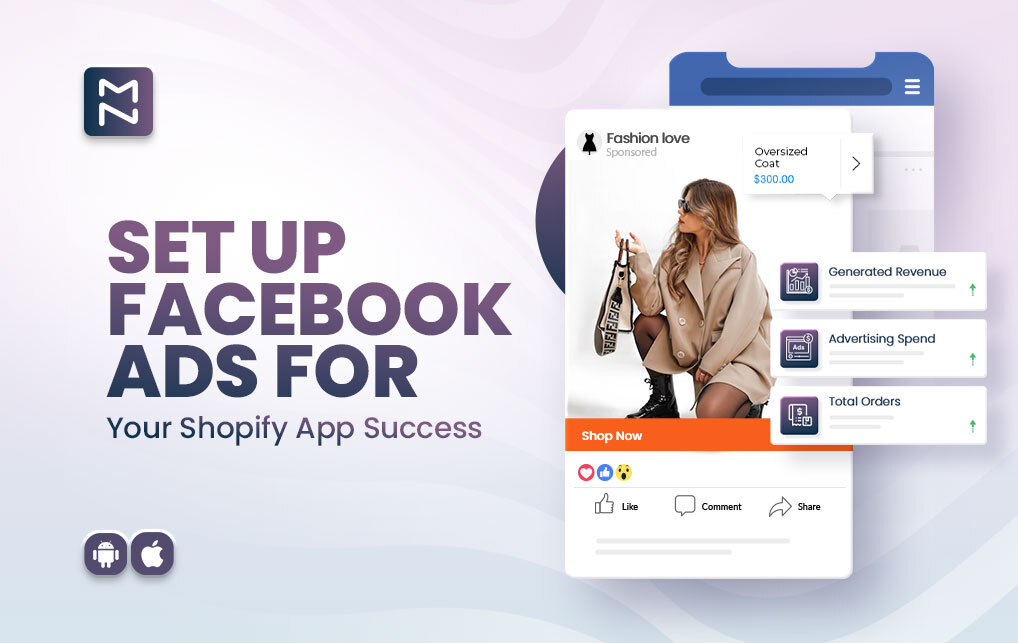









Thanks for your blog, nice to read. Do not stop.
Thanks.